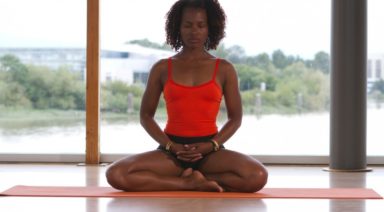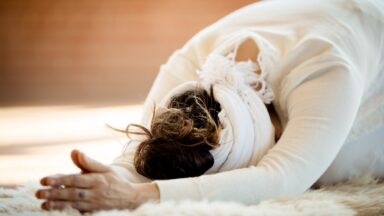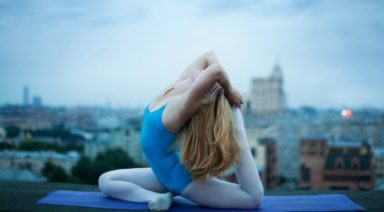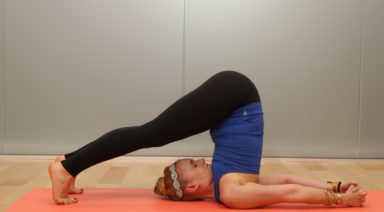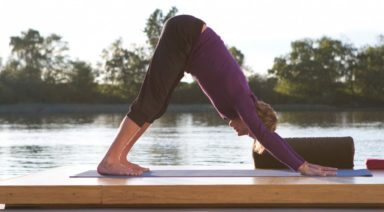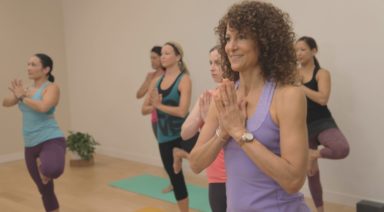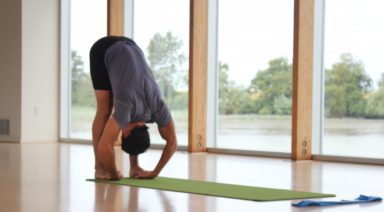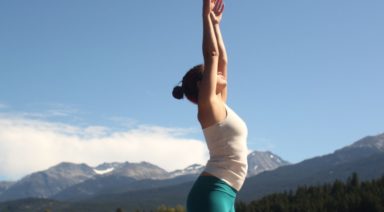The Anatomy of Pranayama: Understanding Our Breath

Full body breathing is an extraordinary symphony of both powerful and subtle movements that massage our internal organs, oscillate our joints, and alternately tone and release all the muscles in the body. It is a full participation with life.
– Donna Farhi, The Breathing Book
Breathing is a simple act we have performed since the moment we were born, but for many of us only becomes illuminated within our yoga practice. We might go all day without noticing our breath until the moment we come to the mat – and observe. Of all the functions of our body, the act of breathing is one of the most fascinating. It is completely subconscious yet we can exert conscious control. It is a muscular act, yet one also controlled by the laws of science that govern molecules of gas. It sustains our life, nourishes our organs, helps expel waste from our body, and can affect our emotional state by acting on our nervous system. Understanding exactly how our body performs this extraordinary act can bring us deeper into our pranayama (breathing) practice.
The Path of the Breath
As we breathe in through the mouth and nose, air flows into our trachea (windpipe) and divides into tree-like right and left bronchi and into the lungs into smaller branching bronchioles. These end in alveoli which are the main site of oxygen and carbon dioxide gas exchange. The lungs are actually dense, sponge like organs that extend from just above our clavicle (collarbone) to our lower ribs. Our right lung is larger than our left due to the close proximity of the heart to the left lung.
The driving force behind our breath is one of the most important muscles in the body: the diaphragm. It is a dome shaped muscle that attaches from our sternum (chest bone) at the front, wrapping around the inside of our lower ribs seven through twelve, and to our spine via finger like projections to L1-4 vertebrae. It separates the organs of our chest from our abdominal and pelvic organs. It also has openings for blood vessels to travel through as well as two muscles: the quadratus lumborum and the psoas muscle. This close relationship with two important muscles of the lower back and pelvis may partly explain why people with low back pain have altered breathing patterns.
Under Pressure
As we inhale the diaphragm lowers, and as we exhale the diaphragm relaxes and rises up. This affects the volume of the thoracic (chest) and abdominal cavities, and in turn the pressure of the oxygen and carbon dioxide molecules. Gases always fill their container. In a large space the molecules are far apart therefore the pressure is low. Much like a busy yoga class, in a small space the molecules are close together so the pressure is high. Since gases flow down a pressure gradient from high to low, when the thoracic cavity volume increases, the pressure decreases and causes air to rush in from the atmosphere. The dimensions only change a few millimeters but it increases the volume of the thoracic cavity by almost half a liter. Inspiration ends when the pressure in the lungs matches the pressure in the atmosphere. On exhalation the diaphragm and other muscles of breathing relax, the lungs recoil, thoracic volume decreases compressing the alveoli and the pressure in the lungs rises again, which forces gases to flow out of the lungs.
You can experience this action on yourself. Place one hand on your upper belly, just below your sternum. As you inhale, notice how your abdominal organs depress and your belly widens as your diaphragm drops down. As you exhale observe the diaphragm rising and your belly resuming its natural position. This natural phenomenon is what your yoga teacher may refer to as belly breathing. In our culture of tummy sucking in, this feeling of letting the stomach expand may feel foreign or require some practice to access.
It Takes a Village
Although the diaphragm is the main muscle of breath, and gas exchange encourages the diaphragm to contract, there are also accessory muscles of breathing that enable movement of the rib cage and sternum essential to the breath. The 12 pairs of ribs attach at the spine to the corresponding numbered thoracic (mid-back) vertebrae. Ribs one through seven wrap around and attach to the sternum. Ribs 8, 9, and 10 are shorter and don’t quite make it all the way around to the sternum so attach at the front to the rib above. Ribs 11 and 12 are known as floating ribs since they have no attachments to the front of the body. Between each rib are intercostal muscles which enable the sternum to move up and out on an inhale, and the ribs to expand 360 degrees in a bucket handle pattern. (Imagine the handle of a bucket resting on a pail. If you were to pick up the bucket, the handle would rise in an arc.)
To experience this phenomenon on yourself, place your hands on the sides of your lower ribs. As you inhale, notice the rib movement not only up but also outwards in all directions. Next wrap your arms around yourself in a hug to feel your upper ribs near your scapula (shoulder blades). Inhale and feel the back of your body expand as your ribs move. We often only think of breath flowing in the front of our body but our back body also moves as the breath moves.
Now Breathe
The act of breathing is not only essential to life; it can be a transformative part of our yoga practice. It can allow us to go deeper into a pose or go deeper into relaxation. It can enable us to let go of distracting thoughts or emotions and make space for positive or calming ones. Understanding the anatomy of our pranayama practice can bring the practice to life, allowing us to picture the miracle that is occurring inside our bodies as we flow to our own individual rhythm of breath.
What is Pranayama?

Yoga as a practice has ancient origins. The first textual mentions of the term can be found in the Rig Veda, which was written around 1500 BCE. While nobody knows exactly how old the practice is, some scholars believe that members of pre-Vedic societies practiced yoga even before that time.
The early yoga of the Vedas was much different that what we practice today. While many modern yoga practitioners have come to associate yoga with the performance of physical postures (asana), all of the earliest recorded texts on yoga hardly mentioned postures at all, and instead tended to emphasize the pursuit of liberation through meditation and pranayama practices instead.
What is Pranayama?
The word pranayama is a compound of two separate Sanskrit terms, prana and yama. The Atharvaveda, (one of the earliest Vedic texts on Indian medicine) states that prana is “the fundamental basis of whatever is, was, and will be.” Other texts often translate prana, as the “life force” or “vital energy”. The complementary term yama is often translated as “restraint” or “control”.
Pranayama then, is typically defined as a set of practices designed to control prana within the human body by means of various breathing techniques, meditative visualizations and physical locks (or kumbhaka).
The Sanskrit language is incredibly rich, and like many languages, one word can often have many different meanings. Some scholars, such as Harvard University Buddhist Chaplain Khenpo Migmar Tseten, prefer to separate the components of the compound into pran and ayama for the purposes of translation. When broken up in this way, pranayama becomes pran, (life-force), and ayama (which has the meaning of expansion or extension). In this case, the conjoined term pranayama takes on the meaning of “expansion of the life force”.
The Benefits of Pranayama
In his book Samadhi of Completion: Secret Tibetan Yoga Illuminations for the Quing Court, Fransoise Wang- Toutain states that “Prana is the driving force of all the functions of the body”, and that “the various functions of the body such as swallowing, digestion, and physical movement were all reliant of the efficient functioning of the prana within the body.”
According to Wang-Toutain (and the tenants of Indian medicine), the roots of all disease and mental imbalance can be traced to abnormalities and deficiencies in the body’s energy flow. In Wang-Toutain’s view, pranayama practices serve as a particularly powerful tool to heal illness and correct mental imbalances since “the control of breathing is the most direct method to affect life force.”
The History of Pranayama – A Timeline
The following timeline gives a general bird’s eye overview of the history of pranayama practices. Though this list is neither intended to be exhaustive nor comprehensive in its scope, it includes a small number of key texts that will be of interest to anyone who wishes to learn more about the history and practice of pranayama.
Brihadaranyaka Upanishad
(Circa 700 BCE)
While references to the the term prana can be found as early as 3,000 BCE in the Chandogya Upanishad, references to pranayama as a breathing practice do not occur until much later in yogic literature (approximately 700 BCE).
One of the earliest recorded references to pranayama as a breath related practice can be found in hymn 1.5.23 of the Brihadaranyaka Upanishad. Clearly linking breathing practices to the regulation of vital energy and life-force, the Upanishad states:
“One should indeed breathe in (arise), but one should also breathe out (without setting) while saying, “Let not the misery that is dying reach me.” * When one would practice that (breathing), one should rather desire to thoroughly realize that (immortality). It is rather through that (realization) that he wins a union with this divinity (breath), that is a sharing of worlds.”
No additional guidelines for pranayama practice are given in this Upanishad. However, the idea that breathing could be used to achieve greater health and even immortality is a theme that is often repeated in subsequent yogic texts and teachings.
The Bhagavad Gita
(Circa Fifth Century to Second Century BCE)
References to pranayama practices can also be found in the Bhagavad Gita, Chapter 4, verse 29. The text highlights the use of conscious inhaling, exhaling and breath retention to effect trancelike states. The text also suggests that the regular practice of pranayama can be used to enact greater control over the senses by “curtailing the eating process.”
The Maitrayaniya Upanishad
(Circa 4th Century BCE)
The Maitrayaniya Upanishad is an important text in the history of pranayama because it contains one of the earliest references to pranayama as a component in a larger, multifaceted system. Most likely composed centuries before the Yoga Sutras of Patanjali, this text enumerates yoga as a six-step process of breath control (pranayama), sensory withdrawal (pratyahara), concentration (dharana), meditation (dhyana), reasoning (tarka) and union (samadhi).
Specific references to pranayama practices can be found in chapter six, verse 21. The text states that deliverance can be accomplished by using a combination of breath retention practices and concentration on the sacred syllable Om in order to redirect prana into the body’s central energy channel (Sushumna).
Patanjali’s Yoga Sutras
(Circa 100 to 400 CE)
Most scholars agree that the Yoga Sutras of Patanjali are a compilation of texts from earlier yoga traditions. By the time of Patanjali, yoga as a system had continued to adapt and grow. The six-limbed system mentioned in the Maitrayaniya Upanishad had grown into eight limbed approach that included asana (physical postures) yama and niyama (social and ethical precepts) pranayama as well as four additional stages of meditative absorption (pratyahara, dharana, dhyana and samadhi).
References to pranayama can be found in verses 2.29 – thru 2.53 of the Sutras. While Patanjali does not go deeply into the nature of prana in these sections, he does detail four separate aspects of the breath: inhale, exhale and retention. In addition, Patanajali also makes reference to a fourth pranayama in sutra 2.51 that he claims surpasses or goes beyond the other three.
In addition, Patanjali notes a number of specific benefits of pranayama practice. These benefits include mental fitness and the ability to concentrate – a prerequisite to deeper states of yoga practice. Additionally, Patanjali states in verse 2:52 that regular pranayama practice could lessen or dissolve the veil that covers our “inner illumination.”
The Hatha Yoga Pradipika
(Circa 1500 CE)
Though traditionalists trace the roots of Hatha Yoga practice to the God Shiva, many scholars associate the founding of the Hatha yoga movement with the Maha Siddha Goraksha Nath. Widely associated with being the founding father of the practice, Gorakshanath is purported to have lived sometime between the 10th and 15th century CE. Numerous texts are accredited to him and his disciples.
One of the most important texts of the medieval era is the Hatha Yoga Pradipika, which was written by Goraksha Nath’s pupil Swami Svatmarama. Drawing from earlier systems, the text emphasizes the attainment of good heath and spiritual realization through a combination of physical postures, pranayama practices and meditative contemplations.
The Pradipika differs from some of the early texts in the history of pranayama, because it more fully details actual instructions for practice. These instructions include specific references to alternate nostril-breathing patterns, details on how to retain the breath, guidelines on auspicious times for practice and an overview of the various signs of progress in pranayama.
Further references to pranayama techniques can be found in a number of additional medieval manuscripts. The most important of these texts include the Gheranda Samhita (late seventeenth century) and Shiva Samhita (seventeenth or eighteenth century CE).
Pranayama Today
While most modern pranayama practices are based at least in part on their original counterparts, contemporary pranayama practices often include a number of additional variations on the basic breathing patterns found in the earlier texts mentioned in this paper.
Modern variants on the practice tend to integrate a combination of modern anatomical knowledge with more traditional yogic teachings in order to refine technique and better explain the physiological and psychological processes that occur when practicing pranayama.
The most notable example of this new approach to pranayama practices can be found in the book “Light on Pranayama”, by the the late B.K.S. Iyengar. A seminal text on modern day pranayama practice, Iyengar’s book is a must read for any student with an interest in the history of pranayama.
Where Should I Begin?
Pranayama practices are best learned under the guidance of a qualified instructor. Though not commonly known, many Tibetan Buddhist monks and nuns practice traditional Hatha Yoga pranayama exercises that can be traced to the 9th century CE. Many contemporary yoga teachers offer pranayama as part of their classes as well. This video on Gaia is a great place to start if you wish to begin the practice.
A Short Exercise for Home Practice
If you wish to begin practicing today, consider trying this alternate nostril breath from the Hatha Yoga Pradipika.
To begin:
- Come to a comfortable crossed legged position
- Block your right nostril, and inhale slowly through the left.
- Hold your breath for a few counts, and then exhale slowly through the right nostril.
- Block your left nostril, and inhale slowly through the right.
- Hold your breath for a few counts, and then exhale through the left.
Repeat the entire cycle for a minimum of seven repetitions. As you become accustomed to the exercise, practice for longer durations.
Practice notes: If holding your breath is uncomfortable at first, begin with very short breath retentions. As the practice becomes more familiar, gradually extend the length of the retention. Breath retention is contraindicated for expectant mothers.




